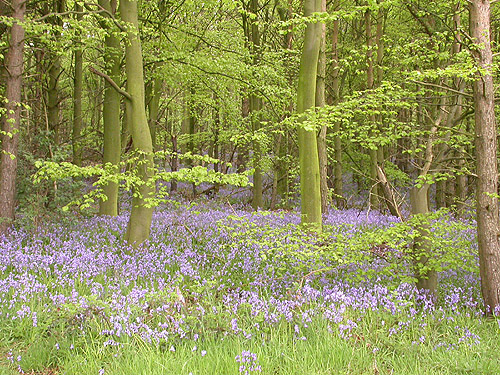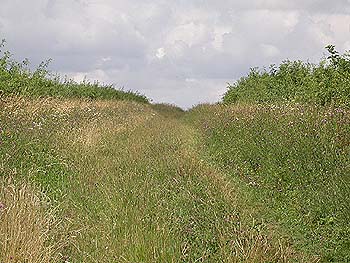

| SINC and SSSI sites at Eakring |
The area presently contains several locally important sites deemed to be of value to wildlife. These are known as either Sites of Interest to Nature Conservation (SINC) or Sites of Special Scientific Interest (SSSI) if the flora and fauna are substantially more important. Eakring Meadows is the only site in the area, presently designated as both and is consquently afforded protection by the Nottinghamshire Wildlife Trust as one of it's nature reserves. Much of the survey work seems to have been botanically based, resulting in these sites being highlighted as being of local importance and attaining SINC or SSSI status. Such survey work was undertaken at Eakring Flash some time ago and the site has yet to be designated any particular status or protection. Becoming a SINC site on the basis of its ground flora alone, is unlikely, though this has developed since 1997. Much of the interest the site creates, is due to it's rank vegetation. |
 |
|
| ..... | ||
The willow scrub, areas of Bulrush, Willowherb and Nettle-beds form this. This is (in itself) a most unique botanical feature within some parts of Nottinghamshire, as most other areas have frequently been "improved" by clearance and then re-sown with a typical grassland mixture. Such a biodiversity action plan is not what is wanted here. There is room for some small-scale scrub clearance, creation of shoreline or shallow island at the southern end, but that is all. It is (beyond any doubt) one of the most important sites within the recording area, consisting of diverse and attractive habitats to a wide variety of fauna, which includes a healthy Water Vole population, 15 species of Odonata and a wide variety of both resident and migrant birds. Existing SINC/SSSI sites All these sites are discussed in more detail on the Recording area page. The recent discovery of the Marsh Pug and it's upgrading to Grade 1 status, has increased the importance of protecting these fragile sites. |
|
| Lound Wood | The only example of a typical "Bluebell wood" in the recording area, which is quite surprising as Hare Hill Wood (less than half a mile away) has none. Certain sections of Lound Wood are carpeted by Wood Anemone. The distinct differences between both Lound and Hare Hill Wood are quite remarkable, despite their short-distances apart. Lound Wood holds the only Purple Hairstreak colony so far found in the area and is now known to support some rare species' of moth. |
| . | . |
| Eakring Meadows | Eakring Meadows Nature Reserve is the most well known of all the sites listed here, but again known through its botanical interest. The attraction of Penny Pasture Common to many migrant birds, seems to have been missed previously. To the birdwatcher, it is Penny Pasture Common that provides most of the interest of all the meadows within the nature reserve. Its scattered Hawthorn scrub virtually annually attracting passage migrants such as Redstart, Whinchat, Stonechat, Wheatear and many warblers. Raptors have included both Marsh and Hen Harrier, Merlin, Hobby and Honey Buzzard. Common Buzzards are semi-resident during the latter half of the year. There is also a diverse insect variety. Recent insect sightings have included the Brown Argus in 2000, then found again along with the Marsh Pug in 2003. The Marsh Pug is now categorised as a Grade 1 species and is found at only one other location in Nottinghamshire. |
| . | . |
| Eakring Pasture | Forms part of the area referred to within eakringbirds.com as The Pastures. Eakring Pasture is technically divided in two by the Eakring to Wellow minor road, on the northern edge of Eakring village. Both fields are grazed annually by horses, but more extensively by sheep throughout 2002. |
| . | . |
| Mill Lane | Is described by the Nottinghamshire Wildlife Trust as a "species-rich, green lane" and runs west, alongside the Oil Bore Holes site for part of its length. The Essex Skipper was found here in July 2003 and the Brown Argus was rediscovered for the first time since 2000. Further searching in 2004, revealed Mill Lane to hold a small Marsh Pug population. |
| . | . |
| Mill Lane extension | Has been given SINC status as an extension to the above lane. |
| . | . |
| Bore holes field | On the map labelled Oil Bore Holes and referred as such within this website. The site has been botanically surveyed before, with a recommendation that "the Hawthorn scrub be removed". Its importance to the recording area, goes beyond it's floral variety (which includes both Bee and Southern-marsh Orchids) attracting large numbers of migrant birds during the Autumn and Winter, but also provides one of a maximum of four Turtle Dove territories here, between 1998 and 2002. During 2002, the site's importance for Turtle Dove was intensified when just two pairs bred. Bullfinch is another scarce breeding species to favour this habitat type. The Brown Argus was present here in 2000 and the Marsh Pug was discovered in 2003, just two of a range of species occurring. |
| The
'bigger picture' There are other areas worthy of protection in an ideal world, which unfortunately does not exist. Many parts of both Eakring and Kersall villages, contain mini habitats that are frequently used by a wider variety of wildlife than one would suppose. Eakring village especially contains some large gardens, many trees out-buildings and open spaces. How long these remain out of the developer's reach remains to be seen. Unfortunately, we live in a world where everything now has a price-tag placed upon it. |
||
| ..... | ||
 |
Even within the space of
five years, many of the area's old farm buildings have
been renovated and modernised. New buildings are also
appearing. Economically this is no bad thing to any
village community or business, but increases the
potential for further reductions in breeding pairs of
Swallow and Swift, two species to have suffered greatly
throughout these "development" years. Any new building application comes under strict planning constraints and guidelines. These are not subject to any relaxing and the owner of one new property here, has been frought with planning difficulties caused by his wish to provide Swifts and House Sparrows with new nesting habitats by leaving small gaps under the eaves. The argument with the relevant planning authority continues. With such difficulty in trying to provide nesting sites from new developments, it is absurd that barns and other out-buildings can be developed reasonably easily, with no implementations placed upon the developer to provide Swallows or Barn Owls with substitute nesting sites. |
|
| ..... | ||
| Unless provided with artificial nesting sites, former breeding species' like the Barn Owl are unlikely to ever make a comeback here. It was not long ago that seven pairs bred in and around Eakring village. There were no records from the area between 1997 and 2001 and this sparsity of sightings alone, sees the Barn Owl currently assuming great rarity status here. | ||